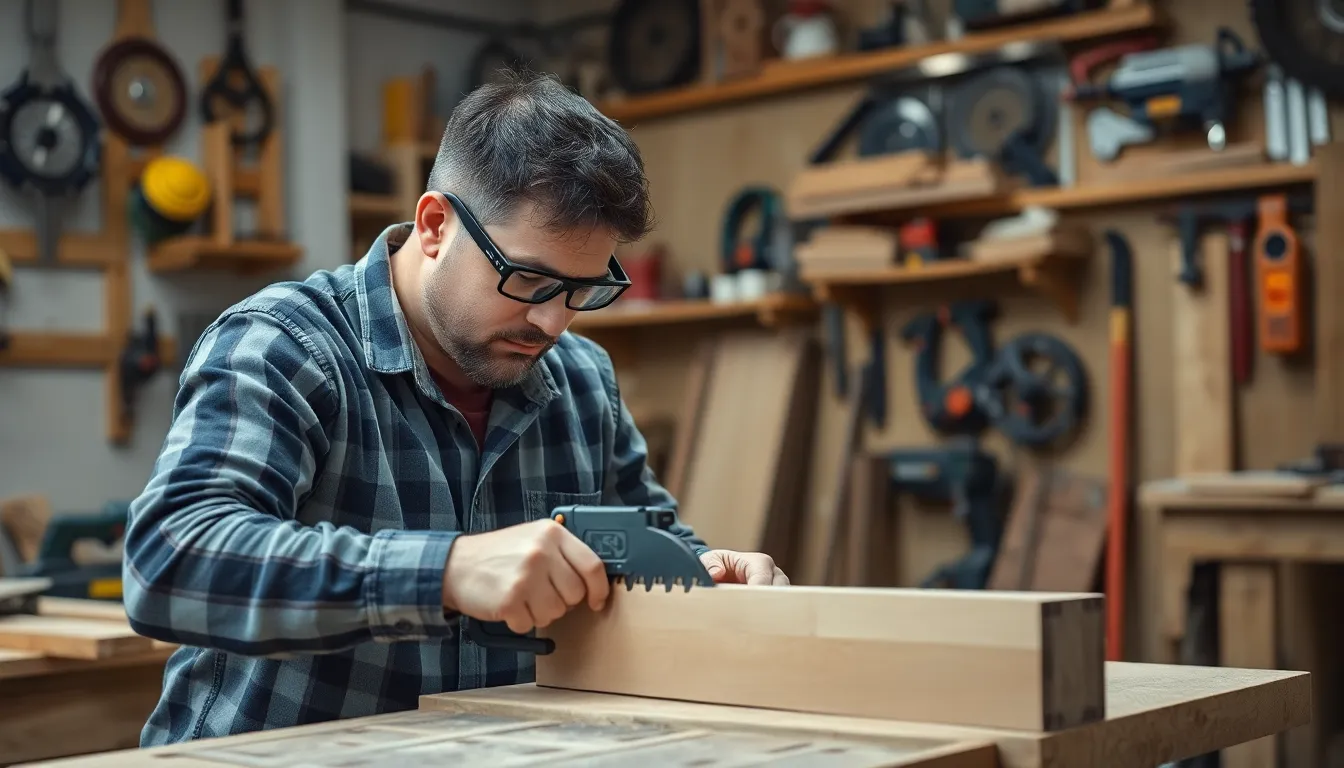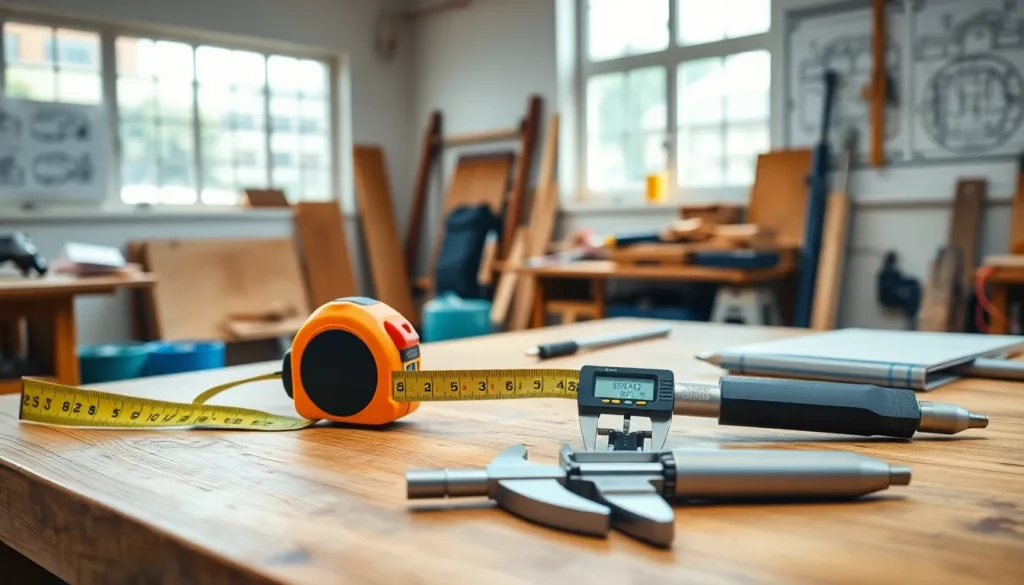In the world of woodworking, cutting tools are the unsung heroes, transforming raw lumber into stunning creations. Imagine tackling a project without the right tools—it’s like trying to cook a gourmet meal with nothing but a butter knife. Not exactly a recipe for success! With the right cutting tools at their fingertips, woodworkers can unleash their creativity and precision, turning their visions into reality.
From saws that slice through wood like butter to chisels that carve out intricate details, each tool plays a vital role in the workshop. Whether you’re a seasoned pro or just starting out, understanding these tools not only boosts efficiency but also adds a sprinkle of joy to the crafting process. So, let’s dive into the fascinating world of cutting tools and discover how they can elevate any woodworking project from drab to fab.
Table of Contents
ToggleOverview of Cutting Tools in Wood Workshop
Cutting tools play a vital role in woodworking, enabling craftsmen to shape and create with precision. Various types of cutting tools exist, each designed for specific tasks and wood types. Saws, chisels, and routers serve as foundational tools in any woodworking workshop.
Saws break down lumber into manageable pieces. Table saws, circular saws, and band saws allow flexibility and efficiency in cutting tasks. Each saw type boasts features that cater to different project requirements.
Chisels provide fine detail work, allowing woodworkers to carve intricate designs. Various chisel sizes accommodate both detailed finishes and broader cuts. Gouges, part of the chisel family, offer unique shapes for specialized carving needs.
Routers function as versatile tools, perfect for shaping edges or hollowing out surfaces. Equipped with a range of bits, routers enable woodworkers to achieve various cuts and designs. Familiarity with router operations enhances creative potential in projects.
Other tools, such as jigsaws and miter saws, contribute to diverse cutting techniques. Jigsaws excel at making curved cuts, while miter saws create precise angles for joints and frames. Understanding these tools enhances accuracy and efficiency during woodworking tasks.
Maintenance of cutting tools ensures longevity and performance. Regular sharpening of blades and chisels not only improves cutting ability but also promotes safety during use. Clean, well-maintained tools foster a more productive workshop environment.
Knowledge of cutting tools and their specific applications elevates woodworking skills. Each tool serves a unique purpose, contributing to the artistry and precision of woodworking projects.
Types of Cutting Tools

Cutting tools are vital components in a wood workshop, each designed for specific tasks. Understanding these tools helps woodworkers hone their skills.
Hand Tools
Hand tools provide precision and control in woodworking tasks. Saws like hand saws and coping saws excel in making intricate cuts. Chisels are ideal for carving and pare wood down to a fine finish. Other hand tools include block planes, which smooth surfaces, and utility knives, which offer versatility in trimming. Portable and easy to use, hand tools encourage craftsmanship and attention to detail.
Power Tools
Power tools increase efficiency and speed in woodworking projects. Circular saws dominate for straight cuts in various materials. Jigsaws allow for versatile cuts, including curves and intricate shapes. Miter saws excel in producing precise crosscuts at angles, critical for frames and joints. Routers facilitate edge shaping and hollowing techniques, enhancing creativity. Each power tool simplifies specific tasks, making the woodworking process faster and more enjoyable.
Selection Criteria for Cutting Tools
Selecting the right cutting tools is essential for any woodworker. Various criteria guide this decision-making process.
Material Considerations
Wood types influence tool selection significantly. Hardwoods like oak demand robust tools for effective cutting, while softer woods, such as pine, allow for easier handling and less wear on blades. Stainless steel and high-carbon steel are popular choices for blades due to their durability and sharpness. Additionally, the coating on blades can affect performance and longevity. Choosing tools that accommodate specific materials enhances accuracy and safety during cutting tasks.
Tool Purpose
Each cutting tool serves a unique function in woodworking. Saws enable woodworkers to perform straight cuts or intricate shapes. Chisels offer precision for detailed work, including carving and joint fitting. Routers are versatile, enabling edge shaping and grooving for decorative projects. Jigsaws excel in performing curved cuts, while miter saws provide accuracy for angled cuts. Understanding the purpose of each tool allows woodworkers to select the right one for specific tasks, improving overall project outcomes.
Maintenance of Cutting Tools
Proper maintenance significantly enhances the longevity and effectiveness of cutting tools. Regular upkeep ensures optimal performance, contributing to woodworker safety and project success.
Cleaning Techniques
Cleaning cutting tools involves removing sawdust and resin buildup. Use a soft brush or cloth for surfaces, ensuring no debris remains. For stubborn residue, mild soap and water work well; dry thoroughly to prevent rust. Occasional lubrication with machine oil protects metal parts. Maintain hand tools by wiping them down after each use to minimize buildup. Power tools should be unplugged during cleaning to enhance safety. Always inspect tools for damage during the cleaning process, addressing any issues promptly.
Sharpening Methods
Sharpening cutting tools keeps edges crisp and effective. Various tools require specific techniques. For chisels, a wet stone or sharpening jig provides precise angles. Saws benefit from a file, with even strokes along the teeth. Routers and blades often need honing on sharpening stones for a clean finish. Electric sharpeners offer a quick option, but user caution is important. Regularly assessing the sharpness of tools before use prevents frustration and promotes accuracy in projects. Prioritize sharpening to ensure quality results in every woodworking endeavor.
Safety Practices in Using Cutting Tools
Using cutting tools safely in a wood workshop is crucial for preventing accidents and injuries. Always wear appropriate personal protective equipment (PPE), including safety goggles and ear protection, when handling tools. Comfortable clothing should remain fitted to avoid getting caught in equipment.
Familiarize with each tool’s operation before beginning any project. Understanding the specific functions and features helps in using tools effectively. Additionally, keep hands away from blades and cutting surfaces to reduce the risk of injuries.
Proper workspace organization is essential for safety. A clutter-free area allows for better concentration and reduces tripping hazards. Store cutting tools securely when not in use to prevent accidents.
Regular tool inspections contribute to safety. Check that blades are sharp and free from damage. A dull blade requires more force, increasing the likelihood of slips.
Power tools demand particular attention. Ensure that guards are in place and operational. It’s important to maintain a firm grip while using these tools and avoid distractions.
Be mindful of the material being cut. Understanding wood types can influence cutting techniques. Softer woods may require less force, while hardwoods will need sharper blades and steady pressure.
Always follow manufacturer guidelines for operating cutting tools. Each tool has specific instructions that enhance safety and performance. In the event of malfunction, cease use immediately and consult a professional.
By adhering to these practices, safety during woodworking can significantly improve. Woodworkers can focus on creativity, transforming raw materials into stunning pieces while minimizing risks.
Cutting tools are the backbone of any wood workshop. They empower woodworkers to bring their visions to life with precision and creativity. By choosing the right tools and maintaining them properly, woodworkers can enhance both their skills and enjoyment of the craft.
Safety should always be a priority in the workshop. With the right practices in place, woodworkers can focus on their projects while minimizing risks. Understanding the unique functions and requirements of each tool ensures that every cut is executed with confidence.
Investing time in learning about cutting tools not only improves the quality of work but also fosters a deeper appreciation for the artistry of woodworking. Embracing this knowledge opens the door to endless possibilities in crafting beautiful wooden creations.










